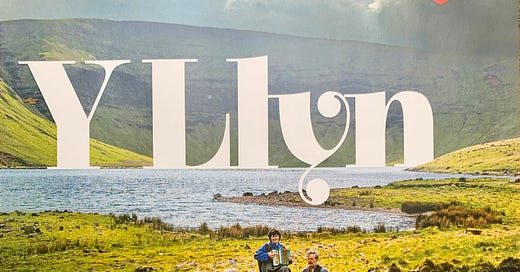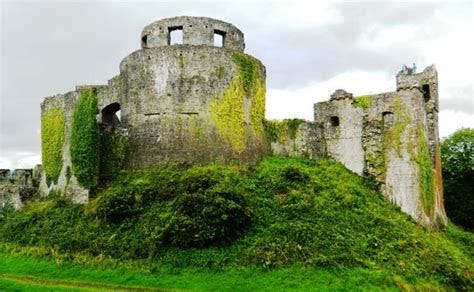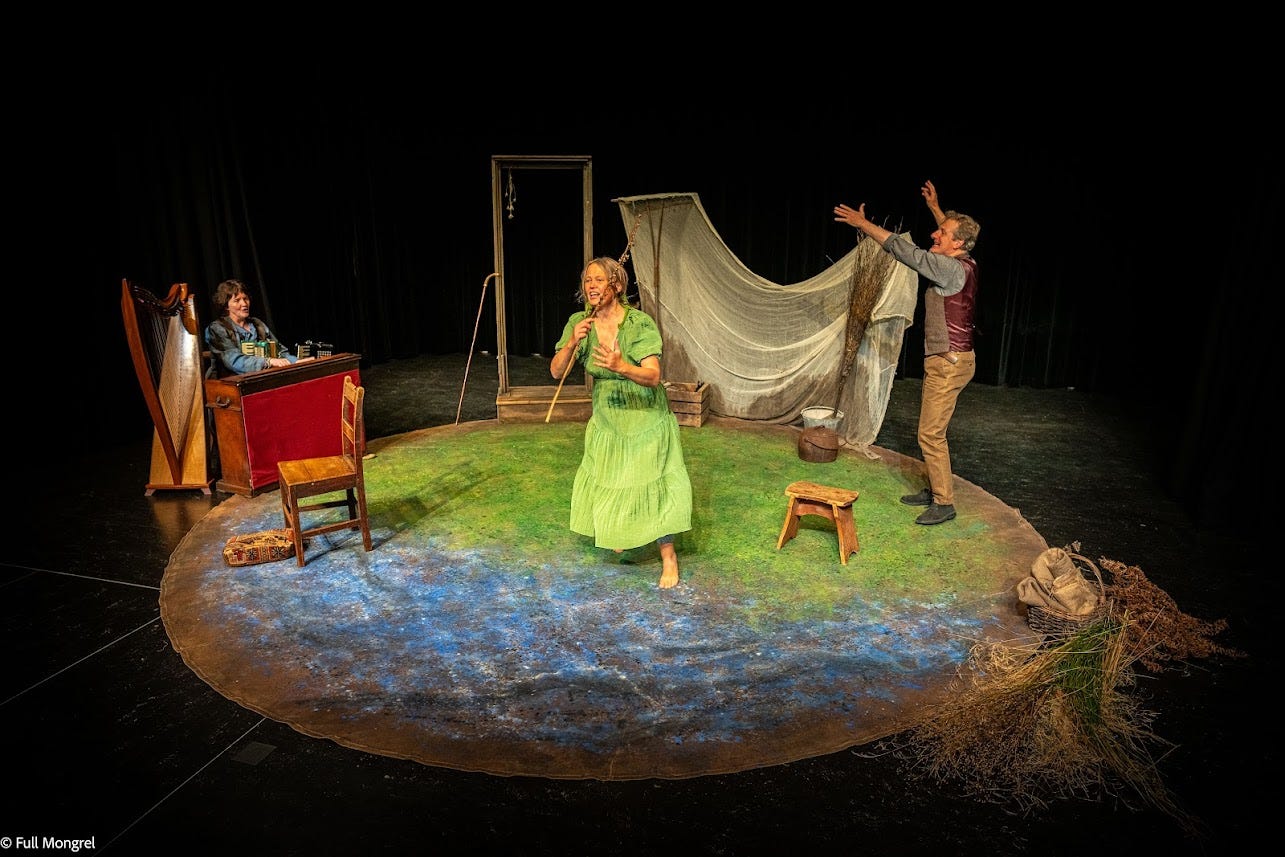This is a bilingual post. Scroll Down for English...
Trosolwg o fynd ar daith gyda'r Llyn
Mae, Eeva-Maria Mutka, Stacey Blythe a finnau newydd orffen taith Y Llyn ar hyd a lled Cymru. Mae’r perfformiad yn cyfuno adrodd straeon, dawns a cherddoriaeth. Roedd y prosiect yn rhywbeth hollol newydd yn ogystal â bod yn rhywbeth oedd wedi bod yn byrlymu yn fy mhen ers dros ddegawd.
Mae’r sioe yn seiliedig ar chwedl adnabyddus Llyn y Fan Fach. Rydyn ni'n defnyddio'r fersiwn o Fyddfai ond mae llawer o fersiynau tebyg eraill ledled Cymru. Mae fersiynau eraill mewn gwledydd eraill gan gynnwys yr Eidal, gorllewin Affrica a Brasil.
Roedd rhan fwyaf y grant wedi’i wario ar gyfres o weithdai estynedig a ddigwyddodd dros un penwythnos y mis am gyfnod o flwyddyn. Prin iawn allwn ni, yn y DU, ddychmygu y fath haelioni lle mae gwariant y pen o’r llywodraeth yn £16.6 . Mae Ffrainc yn gwario £37.8 y pen.
Fe wnaethon ni ariannu’r broses gychwynnol diolch i grant Cyngor Celfyddydau Cymru o’r enw Gwobr Fawr Cymru Creadigol, sy ddim ar gael bellach, gwaetha’r modd. Defnyddiais i’r arian i fynychu trydedd Labo La Maison du Conte, prif sefydliad chwedleua Ffrainc, o dan arweinyddiaeth Abbi Patrix. Fe yw’r dyn wnaeth fy ysgogi (a llawer eraill) i ymuno â’r adfywiad chwedleua. Es i i La Maison du Conte am benwythnos unwaith y mis dros flwyddyn a braf iawn oedd cael ymdrochi ym myd y chwedl am gymaint o amser. Pen llanw’r prosiect oedd cael gweithio gydag Oshi Oida o gwmni Peter Brook.
Defnyddiais i’r wobr er mwyn dyfnháu f’ymarfer creadigol a phen llanw’r prosiect oedd treulio tridiau yn arbrofi gyda chwedl, cerddoriaeth a’r corff yn stiwdio Penpynfarch ger Llandysul gydag Eeva-Maria a Stacey yn ogystal â bachu ar y cyfle i weithio gyda Miranda Tufnell
Cam olaf y prosiect oedd mynd i mewn i stiwdio ymarfer nôl yng Nghymru i weld beth allai’r tri ohonon ni (Eeva-Maria Mutka, Stacey Blythe a finnau) roi at ei gilydd. Fe weithiodd yn ddigon da yn stiwdio Penpynfarch i fentro perfformio o flaen cynulleidfa fyw. Roeddem yn rhan o raglen Gŵyl Beyond the Border Gorffennaf 2021 a chawson ni ein gwahodd i berfformio ein darn newydd ar y gwair o flaen hen furiau cadarn y castell.
Cwrddon ni â’r dyn camera Sam Irving ar y safle ac roedd e'n hapus i dreulio peth amser yn ein ffilmio ni.
Er mai castell y Normaniaid oedd e yn wreiddiol fe ddeaeth yn symbol o bŵer milwrol a gwleidyddol y Cymry. Ar ben hynny, comisiynodd yr Arglwydd Rhys Abaty Ystrad Fflur, lle ysgrifennodd y mynachod rhai o’r straeon hynafol y Mabinogion sydd, hyd heddiw, yn rhan sylfaenol diwylliant a chenedligrwydd Cymru.
Mae dwyieithrwydd yn rhan hanfodol o’n fordd o berfformio ac wedi dod yn fwyfwy pwysig wrth i’r gwaith a’r protocolau creadigol ddatblygu. Mae Cymru yn wlad ddwyieithog ac, fel llawer o wledydd tebyg, mae deinameg pŵer anghyfartal rhwng y ddwy iaith. Mae bron pawb yng Nghymru yn siarad Saesneg ac mae tua 20% yn siarad Cymraeg hefyd. Dau gan mlynedd yn ôl roedd Cymru bron yn wlad uniaith Gymraeg. Os ydych chi eisiau darganfod pam nad yw hi bellach, fe allech chi edrych ar y post hwn. DOLEN
Nid y Cymry yn unig sy wedi colli nifer fawr o’u siaradwyr cynhenid a gwelir yr un peth mewn sawl rhan o'r byd. Yn FEST 2024 (Cynhadledd Ffederasiwn Chwedleua Ewrop) yn Glasgow. Roeddwn i fod i roi cyflwyniad ar dduliau adrodd straeon yn ddwyieithog ond roedd rhaid i mi newid cyfeiriad pan deimlais fod gan y gynulleidfa lawer mwy o ddiddordeb yng ngholled eu ieithoedd eu hunain a sut i ddelio ag ef. Gallwch ddarllen y post llawn yma.
Roedd Sam eisoes wedi gosod ei offer fideo a sain a, chyn bo hir, roeddwn ni’n mynd trwy’r sioe. Roeddwn ni’n credu ein bod ni ar ein pennau ein hunain ond, pan orffennon ni, clywon ni gymeradwyaeth – oddi uchod! Edrychon ni i fyny a gweld hanner dwsin o bobl oedd wedi dod i weld beth oedd yn mynd ymlaen. Roeddwn ni ar lefel y ddaear a’r gynulleidfa annisgwyl uwch ein pennau, yn edrych drwy ffenest ganoloesol. A, chwarae teg iddyn new, pan orffenon ni - fe glapion nhw!
Roedd hi'n bwrw glaw llawer y diwrnod hwnnw. Gymaint, a dweud y gwir, nes bod un o'r grwpiau oedd wedi defnyddio pabell fawr i arddangos a gwerthu eu nwyddau, bacio a mynd adref. Bachon ni ar y cyfle’n chwap! Roedd hi’n ddigon sych tu fewn i ni allu ymarfer ac, ar ôl i ni ddechrau’r sioe, daeth pobl chwilfrydig a dewr draw i weld beth oedd ar y gweill. Y babell sych oedd y prif atyniad i ddechrau ond, yn fuan, daeth eraill a, diolch i’r drefn, roedden nhw wedi gwirioni ar y sioe.
A dyna fe. Roeddwn ni’n gwybod, beth bynnag a ddaw, roedd rhaid i ni greu sioe go iawn allan o hyn. Ar ôl cwpl o geisiadau aflwyddiannus i gyrff ariannu cawson ni sêl bendith Cyngor y Celfyddydau ac, ar ôl treulio peth amser yn ail-ymarfer gyda'n dramaturg Paula Crutchlow - ffwrdd a ni!
Mae rhaid talu teyrnged i’n partneriaid creadigol. Hebddyn nhw fyddwn ni ddim wedi creu’r sioe na mynd ar daith! Diolch yn fawr i Adverse Camber, a’i gynhyrchydd, Naomi Wilds a gweddill y tîm gwych!
And here is the English version…
Myself, Eeva-Maria Mutka and Stacey Blythe have just finished a twelve date tour of storytelling, dance and music the length and breadth of Wales. The project was both something totally new as well as something that had been bubbling away for over a decade.
The show is called Y Llyn (“the Lake” in Welsh) and is based on a well-known folktale. We use the version from Myddfai but there are many other fractal versions of the same story throughout Wales. There are also similar versions from much further afield including Italy, west Africa and Brazil.
We funded the initial process thanks to an Arts Council Wales fund called the Major Creative Wales Award which is sadly no longer available. This allowed me to attend monthly weekends over a period of a year in La Maison du Conte, a premier storytelling organisation just outside Paris, led by Abbi Patrix, the man whose work prompted me (and many others) to get on the storytelling wagon. The high point for me was the priveledge of training with Oshi Oida, Peter Brook’s right hand man!
Most of the money was spent in an extended working process that took place over a weekend per month for a year. This is something that is barely imaginable in the UK where the per capita spend on the arts is £16.6 per capita while the French government spends 37.8 per capita.
The final phase of the project was to get in a rehearsal studio back in Wales to see what myself, Eeva-Maria and Stacey could come up with. It seemed to work so the next phase was to put it out in front of a real live audience. We were part of the programme of the July 2021 Beyond the Border Festival and were booked to perform our new piece outside, in the grounds of Dinefwr Castle near Llandeilo in west Wales.
When we were there we made friends with the cinematographer Sam Irving and he was obliging enough to spend some time filming us. The first attempt was on the lawn inside the curtain wall of the castle.
The castle was repurposed from an English site by yr Arglwydd Rhys (Lord Rhys) in the 12th century. Building a castle was a direct challenge to Anglo-Norman power and, on top of that, Rhys also gave patronage to Abaty Ystrad Fflur (Strata Florida) where the monks wrote down the ancestral stories of the Mabinogion which are, to this day, part of the bedrock of Welsh culture and nationhood.
button
When we arrived at the festival site we really felt the need for some more work on the piece to bed it in a bit more before showing it to anyone. We had made friends with the film maker Sam Irving who was also working on the site and, when the rain started, we made for one of the towers, hoping that no-one would come and watch.
Sam was already assembling his video and sound kit and before long we were performing the show. We thought we were on our own but when we finished, we heard applause - from above!
We looked up and saw half a dozen people who had come to see what the noise was all about. We were on the ground level and the impromptu audience was above us, looking through a medieval window. And, bless them, when we finished - they clapped!
It rained a lot that day, so much in fact, that one of the groups that had used a large tent to display and sell their wares packed up and went home. We pounced! It was dry enough inside for us to work and, once we started the show, other curious and hardy people came along to see what was up. Initially the dry tent was the main attraction but soon others gathered and we could tell that they were hooked. And so were we! Whatever happened, we had to make this thing we’d created into a proper show!
After a couple of unsuccessful applications to funding bodies (par for the course) we got the go-ahead and, once we had spent some time re-rehearsing and with our go-to dramaturg Paula Crutchlow, away we went! In fact, it looked something like this…
Bilingualism is a core part of what we do and has emerged to become more and more important as the work and creative protocols have evolved.
Wales is a bilingual country and, like many other similar countries, there is an unequal power dynamic between the two languages. Pretty much everyone in Wales speaks English and around 20% of those speak Welsh. Two hundred years ago Wales was predominantly a monoglot Welsh speaking country. If you want to find out why it no longer is you could have a look at this post.
Language loss is not just a Welsh phenomenon but is seen in many parts of the world. At the FEST (Federation of European Storytelling) in Glasgow I was due to give a presentation on bilingual storytelling but had to veer off piste when I felt that the audience were much more interested in their own language loss and how to deal with it. You can read the full post here.
I think that being born Welsh and learning Welsh are two very different paths to the same place. I came to Wales in 1984 without a single word of Welsh in my head. If you’re interested in my Welsh language learning journey you can find out more here.
Here is a key component that makes our bilingual storytelling immediate and real…
Code Switching - if you are bilingual you almost definitely do this already. It’s the way that speakers of more than one language will swap between languages, typically to make a comment on what they or someone else in the conversation has just said. Most of the people on the planet ar bi or multilingual so most of the people on the planet are also doing it. It’s completely normal.
Majority and Minority Languages -We give our audience the credit of being able sink into the experience of a show that may not use languages in the way they expect. In fact, seeing as the consensus is that words account for only around 7% of the received meaning, that leaves a lot of leeway for other communicative and somatic guides and context to lead us into what the person in front of us is trying to communicate.
Most of the people reading this article will be monoglot English speakers without another language so, in order for them to understand what I’ve written, I have made an English and Welsh version of this article. This is necesarry because the page does not do nuance, irony and double-meaning in the same way that our embodied speaking does.
Bilingual Storytelling - You can find out about my early experiments with bilingual storytelling here. I have done solo shows using Code Switching between Welsh and English for many years and this project has allowed us to take the creative protocols wider and deeper to include music and dance as well as set and costume.
Here are the basic protocols and methods we use.
This is the skinny version. If you want to know more just message me. I’m happy to chat!
I have developed a way of telling stories bilingually. My experience is as a bilingual speaker who has access to a big language (English) and a smaller language (Cymraeg/Welsh)
The inequality of the languages is an opportunity. It means that everyone in the room understands the English that I use. This is why I use English for context. Once context is established the movement, music and storytelling take on meaning and relevance and the Cymraeg/Welsh becomes transparent. The monoglot English-speaking members of the audience have the experience of understanding what is being said. The meaning of what is happening on stage is comepletely clear and unambiguous even if many of the words are not.
Declare the games you are going to be using early on so your audience can settle into the story without getting distracted by the form/s you might be using. Stacey, our musician, is already on stage when the first audience members sit down and she plays a gentle overture on a harmonium. Once the audience are used to this Eeva-Maria enters. Her movements are dance-based and she is behind a gauze backdrop which makes her seem separate from Stacey’s audience-directed playing. Once those elements are in place Michael, the storyteller, enters and starts the narrative and we pass the ball from one to the other throughout the show, adding layers as we go.
Look who’s talking There is a clarity in the way we speak when we embody character. The show starts with music as the audience come in. Once they’re settled Eeva-Maria enters but stays on the far side of the gauze backdrop. When Michael comes on he does so as a storyteller rather than character. This means that his gaze goes into the audience so that we set up a mutual gaze between himself and the audience. As storyteller he is able to use his gaze to engage the world of the story, the real world space of the theatre and the other performers. All these skills are easy for the audience to read because they are in use in our everyday, social storytelling.
Stacey’s music is, at the same time, supporting and energising the material without direct illustration. When not playing, Stacey takes her gaze into the audience as well as looking at the other performers. This reminds me of the major/minor protocols that Philippe Gaulier passed on in a group training with Cardiff Lab (now known as CPR). It is simply a way of being on stage where you either take attention onto yourself or pass it on to others. It sounds simple but it really works. This protocol is robust enough for myself and Eeva-Maria to take on the point of view of a human man and otherworldly woman where we, as performers, are clearly ourselves but embodying an intimate moment between a man and woman from the audience’s point of view. On top of that, a protocol evolved whereby Michael speaks the words of the female character while remaining himself. All of this is possible because the skills and protocols are already present in the social storytelling skills that we don’t realise we have. Brecht would have loved this stuff!
Improvisation is a core discipline for us all. The same things happen to the same people in the same order. But, if we are doing our job properly, each time will be different because our élan, gaze and energy will adapt to the audience, the space and many other liminal factors. This keeps us engaged, focussed and on the edge of not quite knowing how the next moment will be. It is also a great way of giving yourself permission to do things you would never normally do.
James Jones Morris made us a great set that fills the stage and fits in a car.
But I don’t think that he, or anyone else, was expecting that Eeva-Maria would ritually destroy the set at the end of the show. Luckily nothing has broken and no-one has got hurt - yet! It is an extreme moment in the show and the transgression of destruction is both scary and deeply satisfying.
Emotional Variety All human emotions are here, often at high energy. The improvisational protocols allow us to pretend we are just playing (which we are) but at the same time something wider and deeper is being summoned which is why I think that this folkloric material which came from the Gwerin/People also has roots going down to the Otherworld. It feels strange writing that down but, embodied on the stage, it feels like the truth as we contact a wider, wiser version of ourselves inside these old stories.
Thanks for reading all the way to the end. Happy to be contradicted or nuanced and to hear about your own experiences in this emerging and exciting field!











Once had the fascinating experience of being present when a native German speaker told a story bi-lingually, using English for the action and German for the emotion. Utterly compelling